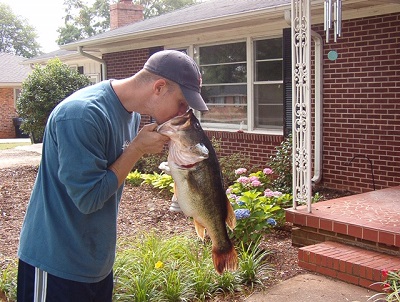It’s hard to beat the feeling (and the smiles that follow) when you put a hook N1. After all, who doesn’t love catching fish? But, when it comes to fish anatomy, they are as equally fascinating as they are to catch.
There are thousands of fish species all over the world. Fish are cold-blooded animals, which means that in most cases, their body temperature can change to mirror the temperature of the water they live in.
A Fish’s anatomy can be divided into external and internal. Let’s start by examining the external anatomy of a fish.
External Fish Anatomy
The external anatomy of a fish includes the fins, scales, gills, eyes, nares, mouth, lateral lines and vents. Let’s take a look at each.
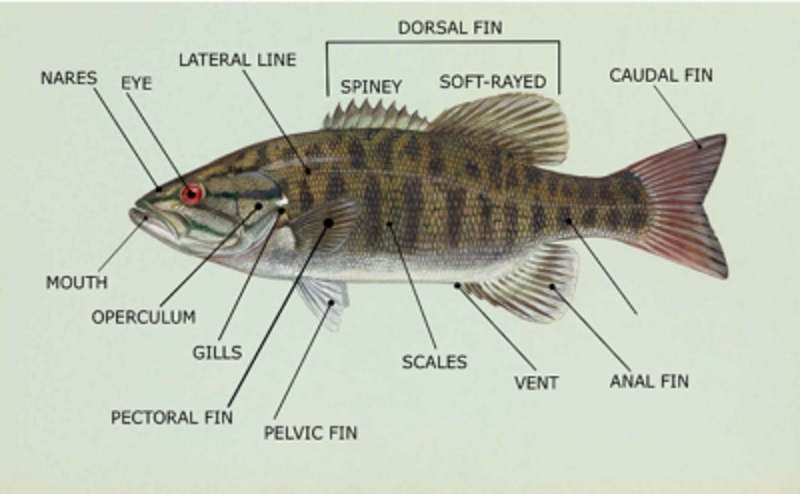
Fins
The fins of a fish are appendages used to move, steer, stop or position. The fins also give the fish balance in the water.
The fins could be single fins (such as the anal fin, the back or dorsal fin, and the caudal or tail fin) or paired fins (they include pelvic or hip fins and pectoral or chest fins) along the centerline of the fish.
Certain fish, such as the catfish, have an adipose fin which is behind the dorsal fin. The purpose of the anal fin and dorsal fin is to help the fish conveniently roll over to their sides.
The caudal fin, on the other hand, allows for propulsion as the fish moves forward. Lastly, the paired fins allow the fish to steer, stop, and hover around.
>>Join the N1 Outdoors Mailing List for news on all the latest products!
A lot of freshwater fish have spines that support their fins. These rigid spines can be very sharp, thus playing a defensive role in protecting the fish from danger. The catfish, for example, has sharp fins in the dorsal and pectoral area and anglers should be aware and careful when handling these fish.
In some species, the number of spines in the dorsal fin actually helps differentiate between two species, as is the case with white crappie and black crappie.
Dorsal fins and caudal fins, on the other hand, have rays which are frequently branched and are less rigid.
Awesome Fishing Shirt Designs from N1 Outdoors®!
-
Sale!

N1 Outdoors® Dominion™ Tee
$19.99 Select options This product has multiple variants. The options may be chosen on the product page -

N1 Outdoors® Block Logo Tee
Price range: $22.99 through $24.99 Select options This product has multiple variants. The options may be chosen on the product page -

N1 Outdoors® Word Cloud Tee (Heather Orange)
Price range: $22.99 through $28.99 Select options This product has multiple variants. The options may be chosen on the product page
Scales
Most bony fish have scales that are either cycloid or ctenoid, except for a few such as the catfish, which doesn’t have a scale, or the gar which possesses ganoid scales.
Cycloid scales have edges which are smooth and rounded while ctenoid scales have edges which are jagged.
To prevent infection, most of the fish have a mucus layer which covers the body. It is important that anglers who intend to return a fish to the water, be very careful with the way they handle the fish, so they don’t mistakenly rub off this mucus layer from the fish. Wetting your hands before handling the fish can help reduce the likelihood of damage to the mucous layer.
Lateral Line
The lateral line in the fish is a group of organs that helps the fish sense the pressure of currents and movement in the water. It consists of a “line” of sacs filled with fluids.
These sacs have sensory apparatus which open to the water by means of pores which creates a line along the side of the fish. The lateral line helps the fish sense other fish as well as prey.
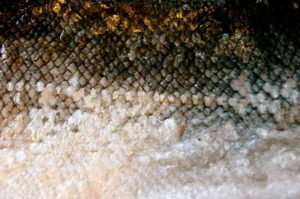
The lateral lines of a fish serve to help them sense other fish… predators as well as prey.
Gills
Fish gills are very delicate and sensitive structures that allow fishes to breathe while they are underwater. The fish gills have a bright, red color because they are highly vascularized.
The gills are protected by a gill cover (operculum) which is a flexible, bony plate.
To breathe, the fish takes in water through the mouth, which passes through the gills and is removed from beneath the operculum.
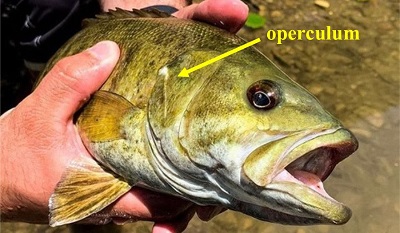
The operculum serves as a protective covering for a fish’s gills. (photo credit: Brad Alan)
Eyes
Fish have well-developed eyes to detect varying colors. While mammals achieve focus by the changing shape of the eye lens, fish achieve focus in the water by the in-and-out movement of the lens.
Nares
The nares are a pair of nostrils which the fish uses to detect odors in the water. These nares are very sensitive. Fish like catfish and eels have a sense of smell that is well developed.
Fish that live in water that is dark or murky, tend to rely on smell more heavily than fish in clearer aquatic habitat.
Fish can also use their sense of smell to detect chemicals in the water, which may indicate predators or even help a fish to locate a mate.
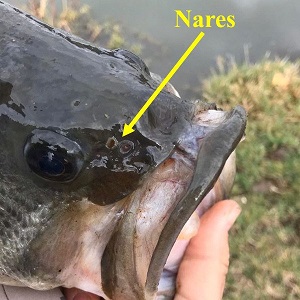
Fish use their nares (or nostrils) to sense odors from predators and prey alike.
Mouth
The shape of a fish’s mouth can dictate the kind of food the fish eats. For example a fish with a larger mouth will tend to have larger prey.
Fish have a good sense of taste, and in some cases, they can taste their prey even before they swallow it. Some fish are omnivores, like many freshwater fish in Florida. Other fish are mainly piscivorous, which means they feed mainly on other fish.
There are also some fish, such as grass carp, that are herbivores, eating plant life. Depending on the species of fish, some may have teeth while others don’t.
Some fish, such as the gar or chain pickerel, have canine-shaped teeth. Others, however, like the catfish have cardiform teeth, which feel like a rough area in the mouth.
Some have vomerine teeth, which are like tiny patches of teeth in the roof of the fish’s mouth. Others, such as the grass carp have pharyngeal teeth which are located in the throat.
The anatomy of a fish’s mouth can affect what type of hook to tie in fishing for particular species of fish.
Vent
In most fishes, the vent is in front of the anal fin. The vents are external openings which open to the reproductive and digestive tracts of the fish. During spawning, the vent serves as an outlet for eggs and sperm.
The vent is also the site where waste is excreted from the body of the fish.
Internal Fish Anatomy
Internal fish anatomy consists of the brain, spine, spinal cord, swim bladder, kidney, stomach and intestines, vent, liver, heart, gonads/eggs, muscles and pyloric caeca. Let’s take a look at each below.
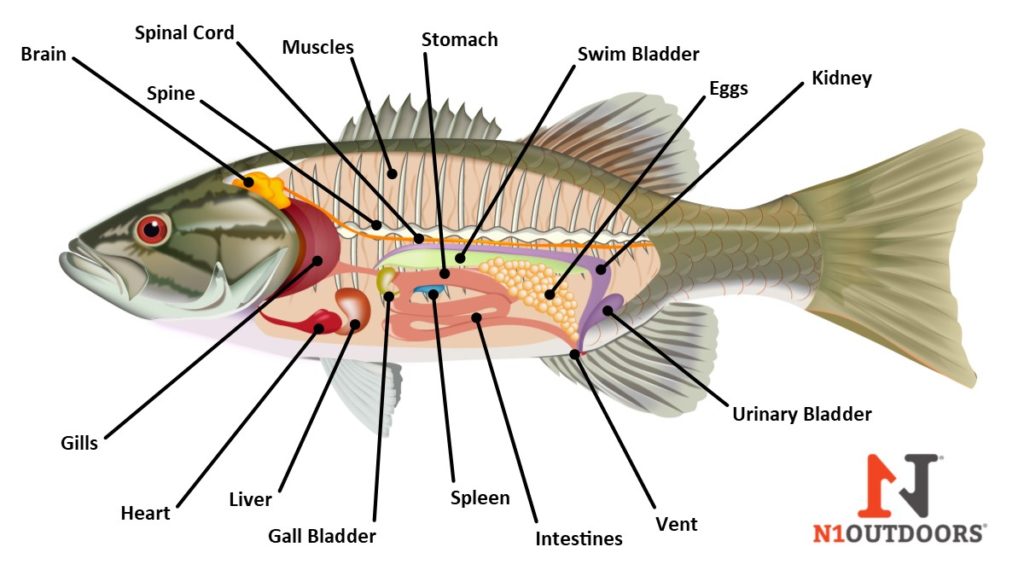
Spine
The spine serves as the primary structural framework of the fish. The fish anatomy as a whole is built upon the spine. The spine also connects to the tail of the fish at the rear and the skull of the fish at the front. Numerous hollow vertebra helps to house and protect the spine of the fish.
The skeleton of the fish can be made of either bones or cartilages.
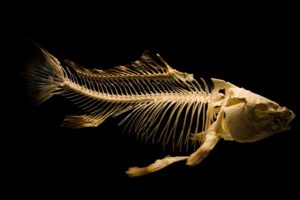
The fish skeleton is the framework for the entire fish.
Spinal Cord
The spinal cord of the fish is connected to the brain of the fish as well as to the rest of the fish’s body. It carries sensory information from the body to the brain and also relays instructions from the brain to the rest of the body.
Brain
It is in the brain that sensory information is processed. This is the center of control in a fish. In the brain, automatic functions such as respiration as well as other behaviors are controlled.
Swim Or Air Bladder
The swim bladder is a hollow organ which the fish uses to conserve energy. The swim bladder functions much like a human lung. The fish draws oxygen into the bladder that has been drawn from the water by way of the fish’s gills. The more oxygen the sac holds, the more buoyant the fish becomes.
Conversely, when the bladder releases oxygen, the fish becomes less buoyant, which allows it to sink to deeper water.
The fish can use the swim bladder to to suspend itself in the water, thus saving energy.
Because of atmospheric pressure difference between the water surface and deep water, fish which were caught from deep waters will need to have some air released from their body before they can return to the deep water.
Some species of fishes, however, do not have swim bladders and because of this, they can sink if they stop swimming.
Kidney
The kidney is a part of the fish anatomy that aids a fish in discharging waste from the body. Waste materials in the blood are filtered by the kidney and then removed from the body. The kidneys also help to regulate the concentration of water and salt in the body of the fish.
Stomach And Intestines
The stomach and intestines of a fish play an important part in the fish’s survival. They help to break down ingested food and to absorb the nutrients. Some fish have short intestines because the food they take is easy to digest. Other fish, such as the herbivores, have longer intestines that help them break down the food they eat.
Pyloric Caeca
The pylori caecum is situated at the junction of the intestine and stomach. It has finger-like projections. Although the function of this organ is not completely understood, the organ has been known to secrete enzymes that help in digestion.
Hunting and Fishing Hoodies from N1 Outdoors®!
-
Sale!

N1 Outdoors® “Sunset Mountain” Pullover Hoodie
$34.00 Select options This product has multiple variants. The options may be chosen on the product page -
Sale!

N1 Outdoors® Est. 2014 Forest Camo Heavyweight Sweatshirt Hoodie
$34.00 Select options This product has multiple variants. The options may be chosen on the product page -
Sale!

N1 Outdoors® Compass Pullover Hoodie
$34.00 Select options This product has multiple variants. The options may be chosen on the product page
Muscles
The muscles of the fish help the fish to move in the water. The fillet of the fish, which is generally the part of the fish that is eaten, is comprised primarily of muscle.
Anyone who has ever caught a fish and had it flip out of your hand has experienced how powerful a fish’s muscles can be.
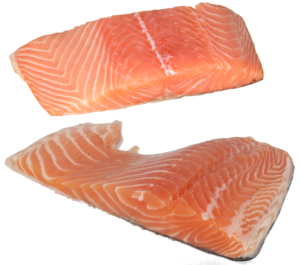
The fish muscles are the powerful force behind a fish’s ability to swim quickly… and also what make them a tasty meal.
Liver
The liver is another important organ with various functions. The liver supports digestion by means of secreted enzymes which break down fats. It also helps to store carbohydrates and fats in the body of the fish.
Old blood cells are destroyed by the liver to maintain the blood chemistry of the fish and the liver also helps in the excretion of nitrogen or waste.
Heart
The heart of the fish helps in blood circulation. Through the blood, various cells and organs of the fish receive digested nutrients and oxygen.
Waste products are also transported by the blood to organs such as the kidney and liver for removal. This function is made possible by the heart.
Gonads
The gonads are the reproductive organs of the fish. They produce sex cells in the fish. Female fish produce eggs by means of paired ovaries while male fish produce sperm by means of paired testes.
The gonads of the fish are located in the same general location. The eggs of some fish are considered a delicacy in certain parts of the world.
Parts of a Fish Conclusion
Whether you eat the fish you catch or practice catch and release, we hope you have learned a lot from this article about fish anatomy and the various parts of a fish. And, of course, we hope you put a hook N1! You can also view fishing tips videos and read our articles on all types of fishing topics.
And, if you love reading about anatomy of wild game, be sure to check out our article on deer anatomy.
Be sure to check out all of our RodTogs™ fishing rod wraps! We have tons of fish scale patterns like:
- Peacock Bass fishing rod wrap
- Largemouth Bass fishing rod wrap
- Mahi Mahi fishing rod wrap
- Rainbow Trout fishing rod wrap
- Brown Trout fishing rod wrap
- Sheepshead fishing rod wrap
- Redfish fishing rod wrap
- Crappie fishing rod wrap
- Longear Sunfish fishing rod wrap
- Spotted Sea Trout fishing rod wrap
- Striped Bass fishing rod wrap

